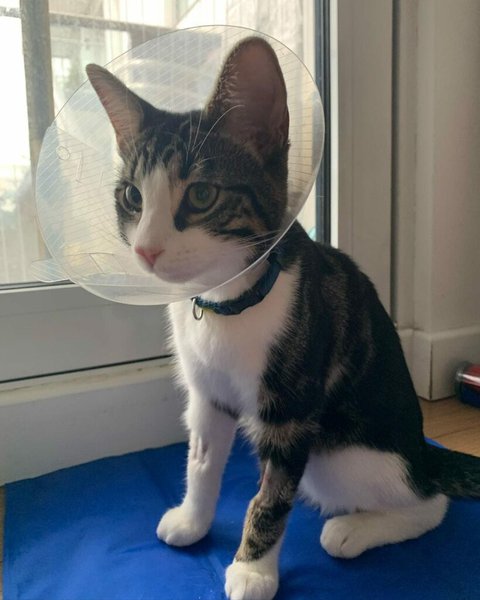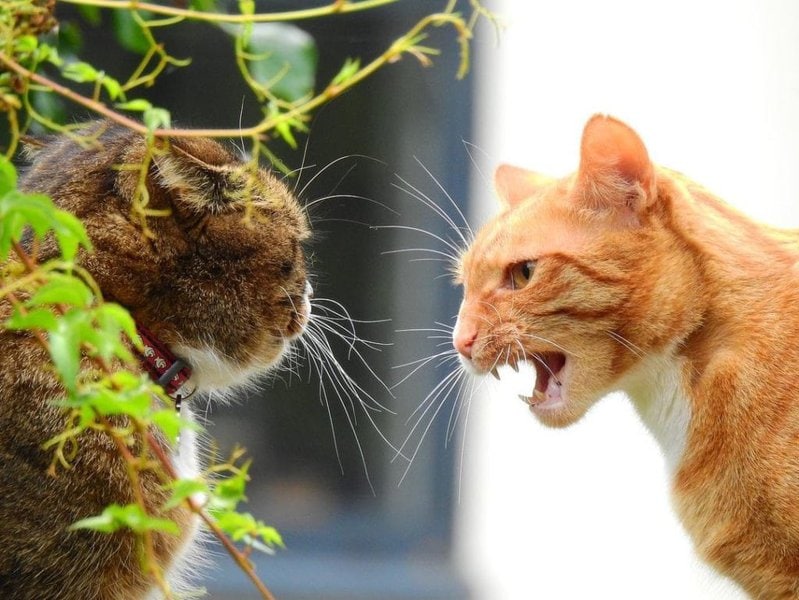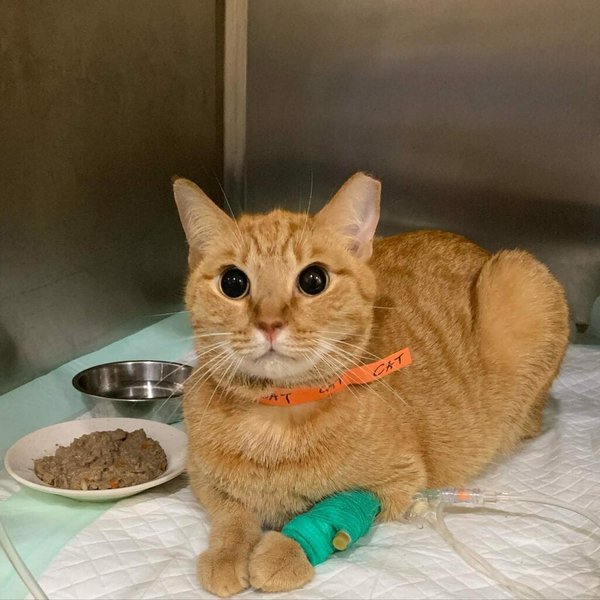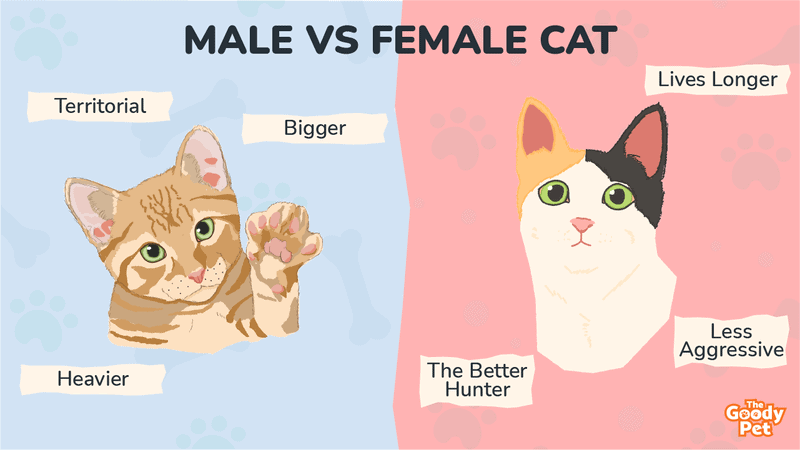If you’re thinking about adopting a new cat, you’ll at one point need to decide whether to get a queen or a tomcat. So, is it better to keep a male or a female cat? Is there a difference between male and female cats, save for the very obvious one?
One of the major differences between male and female cats is their mousing ability. If you’re adopting a cat to help you with rodents, gender is a key consideration. Gender also affects a cat’s cleanliness as well as their level of affection displayed, but these are not the only differences.
Now, let’s take a close look at the key differences between male and female cats.
13. Are Male Or Female Cats Better Mousers?

Just like lionesses are better hunters than their male counterparts, female cats are better mousers than male cats. This can be attributed to the fact that they not only need to hunt for themselves, but also for their kittens.
In addition, as a maternal figure, they are often the ones to teach their kittens how to be good hunters.
Therefore, if you’re getting a cat to help you with rodents, you’re better off getting a female cat.
12. Are Male Or Female Cats Cleaner?

Cats are very meticulous when it comes to cleanliness, and will spend a lot of time grooming themselves. This behavior is common to both male and female cats, so no gender can be said to be cleaner than the other.
If you have more than one cat, the cats will sometimes groom each other. This behavior is common between male cats or both male and female cats. However, this behavior is not common among female cats.
11. Fixing A Cat: Neutering VS Spaying?

Once you get a cat, it is advisable to fix them, either by neutering (for male cats) or spaying (for queens). Fixing your cat prevents unwanted pregnancies (for female cats), and helps prevent unwanted behaviors that are brought about by sexual drive.
So, what is the cost of neutering vs spaying? Generally, neutering a cat is a lot cheaper than spaying. Therefore, if you’re concerned about the cost of fixing your cat, you should go for a male cat.
10. What Gender Of Cats Is More Aggressive?

Intact male cats are generally more aggressive than intact female cats. Therefore, if you don’t want to deal with an aggressive cat, you’re better off getting a female cat.
Note, however, that aggressive behavior will also depend on several other factors, such as breed, and even the personality of the individual cat. Therefore, getting a female cat is not a guarantee that you won’t have to deal with aggressive behavior.
9. Do Female Cats Roam Less Than Males?

All cats love exploring their surroundings. However, roaming behavior will vary between different cats. Generally, intact tomcats tend to display greater roaming behavior compared to intact females, as well as fixed males and females.
If you don’t want a cat who’s always wandering, the best thing to do is to get your new cat fixed. Neutering or spaying eliminates a cat’s sexual drive, which is the greatest driver of roaming behavior.
8. Are Female Cats More Territorial Than Male Cats?

For intact cats, males are usually more territorial. They control larger territories and are more likely to get into fights defending their territory. For fixed cats, female cats tend to be more territorial compared to males.
Cats that are very territorial will often show aggression towards other cats and sometimes dogs, but your cat is unlikely to get aggressive towards people due to territory issues.
7. Are Male Cats More Affectionate Than Females?

Gender can also affect your cat’s displays of affection. So, are male or female cats more loving? A lot of cat owners believe that neutered males are more affectionate than females. However, there are those who believe that girl cats are nicer than boys.
Aside from gender, your cat’s display of love and affection will also be affected by factors such as breed and individual personality, how socialized they were as kittens, as well as their environment.
6. Do All Cats Spray Urine?

Dealing with urine spraying can be frustrating, so it’s something you want to think about before getting a new cat. So, what gender tends to spray more?
Both male and female cats are prone to spraying, though this behavior is more common in males. This is their way of marking their territory. The best way to prevent spraying is to get your cat fixed. However, this is not a guaranteed solution, since some fixed cats retain spraying behavior.
5. Health Issues Of Female Cats

It’s also good to think about possible health issues before getting yourself a new cat. Some of the health problems that female cats are prone to include uterine cysts and tumors, pyometra, which is caused by inflammation of uterine lining tissue, mammary cancer, and false pregnancies.
Fortunately, you can prevent most of these problems by getting your female cat spayed, since spaying removes most of the female organs that are affected by these health issues.
4. Health Issues Of Male Cats

Male cats also have their own unique health issues. Some of the health issues that commonly affect male cats include feline tail gland hyperplasia, which affects the cat’s tail glands and causes infections and leads to production of a foul smelling fluid, as well as testicular cancer, prostate cancer, urinary tract obstruction, and undescended testes.
Unlike with female cats, many of the health problems that affect male cats cannot be prevented by neutering your cat.
3. Do Male Or Female Cats Live Longer?

Before getting a new cat, it is also good to consider how long you’re going to have the cat as a companion. So, who lives longer between male and female cats?
Studies show that female cats tend to outlive male cats by about 2 years. In addition, spayed or neutered cats live longer than intact cats, mixed breed cats tend to live longer than purebred cats, and indoor cats outlive cats that are allowed to roam outside.
2. Coat Color

Gender has a huge impact on a cat’s coat color, and therefore, if you have coat color preferences when choosing a cat, you’ll need to take the cat’s gender into consideration.
If you want a cat with a tortoiseshell or calico coat color, you’ll have to go for a female cat, since these coat colors occur predominantly in female cats. On the other hand, if you want an orange colored cat, you’ll have to get a tomcat.
1. Size And Weight

Male and female cats have differences in size, with male cats being generally bigger and heavier than female cats. Male cats usually weigh up to 12 lbs while female cats usually weigh up to 10 lbs.
However, this 2-pound weight difference between male and female cats is not very big, and therefore, size is not a very significant consideration when it comes to choosing between a male cat and a female cat.
That said, a disadvantage of having male cats is that tomcats will usually require larger litter boxes and bigger space due to their larger size.
Related Questions
Can 2 Male Cats Live Together? Yes, it is entirely possible for 2 male cats to live together only if they don’t see each other as rivals. This can happen if the two male cats were raised together or if they are both neutered. Two male cats can also get along if one is an adult and the other one a kitten.
Are Male Or Female Cats Better Together? Cats of the opposite gender are more likely to get along well compared to cats of the same gender. However, if it is absolutely necessary for you to have cats of the same gender, males are more likely to get along well compared to females. In addition, fixed cats of the same gender get along better than intact cats.
Will Two Female Cats Fight? When two female cats are kept together, there is a high chance that the two will fight. Sometimes, however, it is possible for two female cats to get along. So, how long does it take two female cats to get along? If both female cats are adults, they can take as long as 8 to 12 months to get along.





